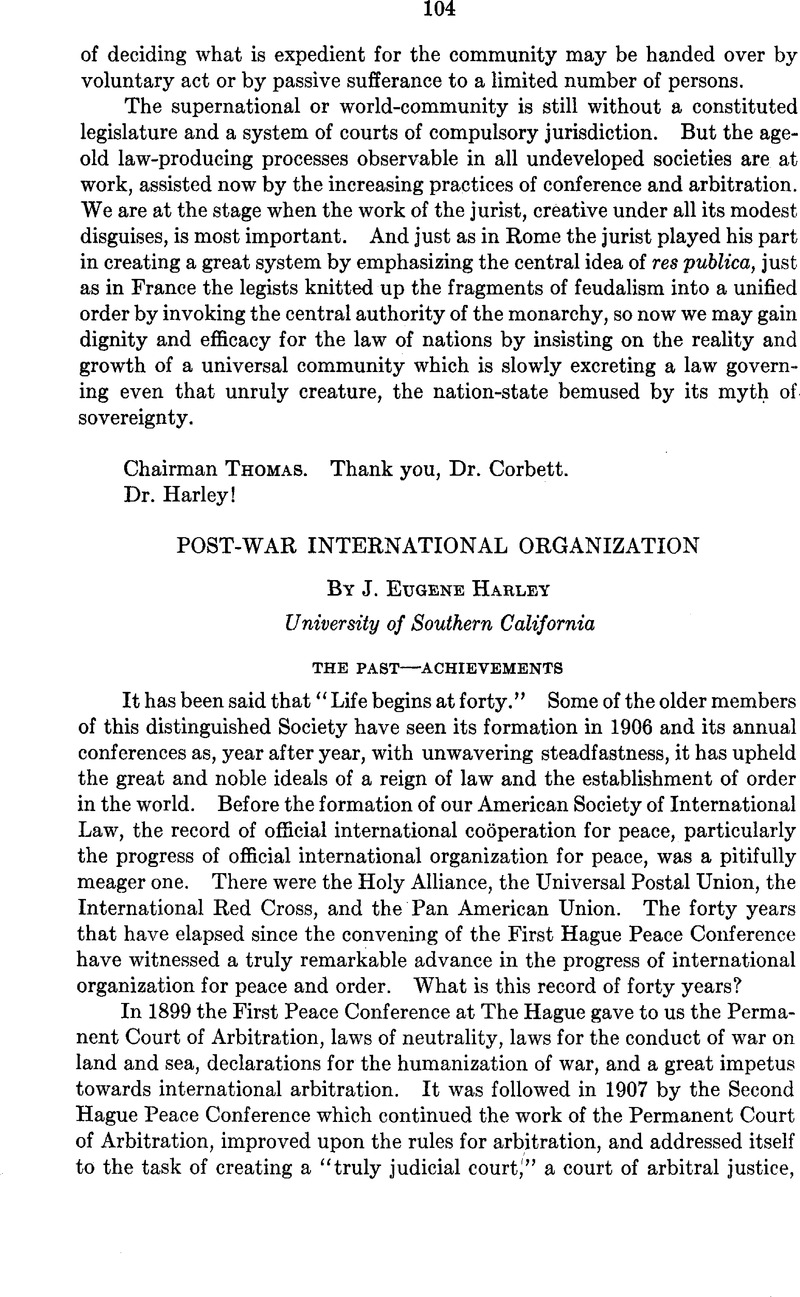No CrossRef data available.
Article contents
Post-War International Organization
Published online by Cambridge University Press: 27 February 2017
Abstract

- Type
- Fourth Session
- Information
- Proceedings of the American Society of International Law at its annual meeting (1921-1969) , Volume 34 , 1940 , pp. 104 - 115
- Copyright
- Copyright © American Society of International Law 1940
References
1 New York, Harper and Brothers, 1939.
2 The fifteen democracies in the Union would be: (1) United States; (2) United Kingdom; (3) France; (4) Belgium; (5) Switzerland; (6) Netherlands; (7) Norway; (8) Sweden; (9) Denmark; (10) Finland; (11) Australia; (12) Canada; (13) New Zealand; (14) Union of South Africa; (15) Ireland.
3 Ruhl J. Bartlett, in criticizing the Streit plan, states that the Federal Union of the United States would never have succeeded if “Virginia, New York, and Pennsylvania had not joined.” See his article “Mr. Streit’s Historical Myth,” New World, February, 1940, p. 8.
4 This Bank would have a capital of $100,000,000; it would seek to promote trade and commerce and to encourage the use of gold and silver in facilitating the transfer of international payments.
5 See Count Richard, N. Coudenhove-Kalergi’s Pan-Europa New York A. A. Knopf 1926 Google Scholar. A recent article by the same author entitled “Can Europe Unite?” appeared in the Christian Science Monitor, Dec. 2, 1939.
6 Dr. William E. Rappard states that Briand’s idea for a European Union was born because of extra-European opposition to the Geneva Protocol. See his article, “Du Fédéralisme international,” L’Esprit International, January, 1940, pp. 3–22.
7 New York Times, Oct. 18,1939. Quoting from address of Mr. Menzies at Melbourne, Oct. 17, 1939.
8 The author has condensed and paraphrased these proposals from the texts used by William P. Maddox in his “European Plans for World Order,” The American Academy of Political and Social Science (Philadelphia, 1940, James-Patten-Rowe Pamphlet Series No. 8), pp. 16–19. Mr. Maddox used “Labour’s Peace Arms,” a pamphlet published by the Labour Party (Transport House, London).
9 Annual Report as Director of the Division of Intercourse and Education of the Carnegie Endowment for International Peace. See New York Times, March 11, 1940.
10 See his latest book, For What Do We Fight? (New York, Harper & Brothers, 1940).
11 See report of his address to the British Students’ Congress at Leeds University, March 28, 1940, as carried in the New York Times, March 29, 1940.
12 See Wells, H. G. The New World Order New York Alfred A. Knopf 1940 Google Scholar.
13 See his extensive article “Du Fédéralisme international,” loc. cit.
14 Proposed at sessions of the American Academy of Political and Social Science, April 12, 1940. See New York Times, April 13, 1940.
15 New York Times, April 13, 1940.
16 For an extensive discussion of this Protocol with texts of proposed amendments, see Hudson, Manley O. “Protocol for the Separation of the League of Nations from the Treaties of Peace,” American Journal of International Law 33 1939 138 145 CrossRefGoogle Scholar.
17 Director of the Institut Universitaire de Hautes Études Internationales, Geneva.
18 For the composition of this Committee and a full report of its activities and recommendations, see Special Supplement of the League of Nations Monthly Summary, August, 1939.
19 Lord David Davies, one of the leading figures of the New Commonwealth Society, is the author of one of the best-known books dealing with the problem of an international police force. See his volume, The Problem of the Twentieth Century (New York, Putnam, 1931).
20 House Joint Resolution 223, June 20, 1910.
21 See J. Eugene Harley, Documentary Textbook On International Relations (1934), especially Ch. I on “Development of International Coöperation.”
22 From address on the occasion of the First Assembly of the League of Nations, Dec. 13, 1920.




